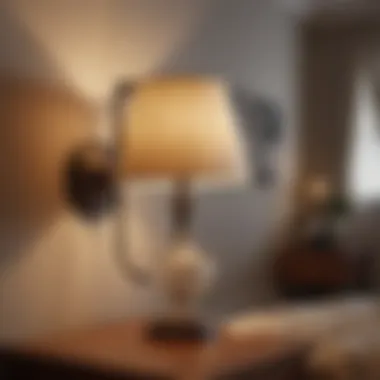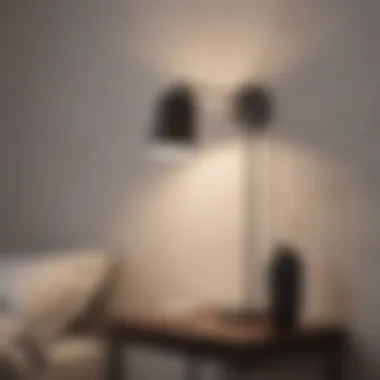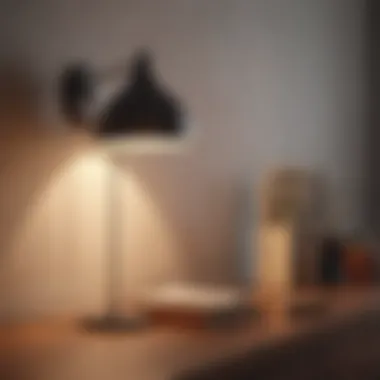Discover the Ultimate Guide to Bedroom Wall Reading Lamps


Intro
When considering the elements that contribute to a well-designed bedroom, the lighting often takes center stage. Bedroom wall reading lamps serve as both functional and aesthetic additions. They not only provide illumination for reading but also enhance the overall room's design. Understanding these lamps' nuances—ranging from styles to installation practices—can greatly improve how one utilizes their bedroom space. This guide will help homeowners and designers appreciate the intricate interplay of light quality, positioning, and design that wall reading lamps offer.
Trending Styles
Modern Minimalism
Modern minimalism has surged in popularity, particularly among those who prefer a clean and uncluttered aesthetic. Wall reading lamps in this style often feature simple lines and neutral colors. Materials like metal and glass are frequently utilized to create sleek and functional designs. For instance, models from designers like Flos emphasize understated elegance, focusing on practicality without sacrificing style. Such choices resonate well in contemporary settings where simplicity is paramount.
Cozy Rustic
On the other end of the spectrum, the cozy rustic style evokes warmth and comfort, making it a favorite among homeowners who prioritize a relaxed atmosphere. These lamps are often made from natural materials such as wood or wrought iron, showcasing craftsmanship and character. Brands like Pottery Barn provide excellent examples of these fixtures, integrating soft lighting with rugged designs. This style not only adds functionality but also contributes to the intimate ambiance of a bedroom, providing the ideal setting for quiet evenings.
Color Palettes
Calming Neutrals
When selecting bedroom wall reading lamps, color plays a crucial role in shaping the mood of the room. Calming neutrals, such as soft whites and gentle greys, are popular choices. These tones harmonize seamlessly with various design themes, allowing for versatility. Options like the West Elm’s statement pieces can enhance a serene environment, encouraging relaxation and focus.
Bold Accents
Alternatively, bold accent colors can invigorate a space and express individuality. A reading lamp in a vivid color can become a focal point, drawing the eye and adding character. Brands like CB2 often feature striking designs that echo this idea. Using bold accents alongside neutral backgrounds creates an intriguing visual balance, making the bedroom feel vibrant and alive.
"The choice of lighting directly influences the atmosphere of a bedroom, making it essential to select the right styles and colors."
Prolusion to Bedroom Wall Reading Lamps
In the realm of interior design and personal comfort, bedroom wall reading lamps serve as a pivotal accessory. Their significance goes beyond mere aesthetics; they embody functionality, allowing for an enhanced reading experience in one of the most crucial areas of the home—the bedroom. As we delve into this subject, it is vital to recognize the role that these fixtures play in creating an inviting atmosphere conducive to relaxation and reflection.
Firstly, particular attention should be given to how wall-mounted lamps maximize space. Unlike traditional bedside lamps that occupy valuable table space, wall lamps free up bedside surfaces, enabling a cleaner and more organized environment. This is especially beneficial for smaller bedrooms where every inch counts. Additionally, the ability to adjust the positioning of these lamps allows for tailored lighting solutions that can adapt to individual preferences and needs.
Moreover, the design of wall reading lamps contributes significantly to the overall decor. The choice of styles—from modern to minimalist—can harmonize with the bedroom's existing theme, thus elevating the ambiance. Since these fixtures usually come in various materials, such as metal, wood, or plastic, they can integrate seamlessly into a range of design elements.
Another remarkable advantage is the enhancement of focus and relaxation provided by wall reading lamps. Suitable lighting aids in establishing a conducive reading environment, encouraging concentration and reducing eye strain. Many individuals find that a well-lit space makes reading not just easier but more enjoyable, allowing them to unwind with their favorite books at the end of the day.
Finally, the consideration of light quality cannot be overstated. The right bedroom wall reading lamp should emit light that is comfortable for the eyes, with appropriate brightness and color temperature. This choice affects mood and well-being, making it an important factor for homeowners.
The right lighting can transform not just a room, but also how we feel in that space—making it essential for tranquility and functionality in the bedroom.
In this article, we will explore the various aspects of bedroom wall reading lamps, from understanding their purpose to design considerations and types available. This comprehensive guide aims to empower homeowners with the knowledge to create a serene and beautifully illuminated bedroom space, tailored to their individual preferences.
Understanding the Purpose of Reading Lamps
Reading lamps serve a significant role in enhancing the functionality and comfort of bedroom spaces. Their purpose extends beyond mere illumination; they create an environment conducive to concentrated reading. At night, a well-placed reading lamp can become a sanctuary of light, providing the right focus without disturbing others in the room.
Enhancing Focus and Relaxation
The ability to focus is integral for activities like reading or studying. This is where reading lamps become invaluable. A proper reading lamp directs light precisely where it is needed. It minimizes eye strain and allows for longer reading sessions without fatigue.
Research indicates that ambient lighting can help regulate mood and relaxation. When the light is soft yet sufficient, it encourages a sense of calm.
- Direct Lighting: Helps sharpen focus on the text.
- Soft Glow: Promotes relaxation and comfort during reading.
Moreover, the right color temperature enhances this experience. Warmer tones can create a cozy atmosphere while cooler tones may aid in keeping you alert during reading. The choice of light can influence not just the reading experience, but also overall mood.
Improving Bedtime Routines
Integrating reading into a bedtime routine can improve both relaxation and the quality of sleep. A reading lamp, set close to the bed, allows individuals to unwind with a book before sleeping. This practice not only calms the mind but can also signal to the body that it is time to sleep soon.
Having a structured routine can be beneficial for adults and children alike. For instance:
- For Adults: Reading can help transition from daily stress to relaxation.
- For Children: A bedtime story under soft light can develop a love for reading.
This routine can lead to better sleep quality, positively impacting overall health. By fostering a calming pre-sleep habit, wall reading lamps contribute to the creation of serene bedroom environments.
Design Considerations for Bedroom Wall Reading Lamps
When selecting a wall reading lamp for a bedroom, several design considerations come into play. These factors ensure that the lamp not only serves its practical purpose but also complements the overall aesthetics of the room. Design choices can significantly impact the comfort and functionality of bedtime reading. Considerations such as style, materials, and light quality are key when choosing the right lamp. Each element adds to the lamp's visual appeal while enhancing the ambiance of the space.


Styles and Aesthetics
Modern
Modern wall reading lamps are characterized by sleek lines and minimalistic designs. They often feature geometric shapes and a variety of finishes, making them suitable for contemporary decors. The contribution of modern designs lies in their ability to blend seamlessly with various styles, from urban chic to Scandinavian minimalism. A key characteristic of modern lamps is their often adjustable features, allowing for direction of light where it is needed most. This flexibility is beneficial as it supports tailored reading experiences. However, some may find their minimalist approach lacks warmth compared to other styles.
Traditional
Traditional wall reading lamps evoke a sense of classic elegance, often made with ornate details and rich materials like brass and glass. Their contribution to bedroom aesthetics lies in their timeless appeal and ability to create a cozy atmosphere. The key characteristic of traditional lamps is their decorative designs, which add a touch of sophistication to any space. They often come in warm finishes that can elevate the overall look of a bedroom. However, they may require more maintenance to keep them looking their best.
Minimalist
Minimalist wall reading lamps focus on simplicity and functionality. Their designs are straightforward, often lacking elaborate details or decorations. The contribution of minimalist lamps is in creating a clutter-free environment, allowing the focus to remain on reading. A key characteristic of this style is the use of neutral colors and materials that blend into the background. Minimalist lamps are beneficial for small spaces as they do not overwhelm the visual field. However, some may perceive them as too sterile or lacking in personality.
Materials Used
Metal
Metal wall reading lamps are durable and come in various finishes, such as brushed nickel or matte black. Their strength is a significant contribution to the overall quality and longevity of the lamp. A key characteristic of metal lamps is their modern and industrial look. They are often seen as a popular choice for contemporary interiors. The unique feature of metal is its ability to conduct heat, which can impact light bulb choice. While they are sturdy, metal can sometimes feel cold, detracting from a cozy feel.
Wood
Wood wall reading lamps offer a sense of warmth and natural beauty, making them an attractive option for many bedroom designs. The contribution of wood lies in its versatility, as it can complement both traditional and modern decors. A key characteristic is the rich textures and grain patterns that wood provides. Wood lamps are beneficial because they can add a touch of earthiness to the space. However, they may require more care to avoid wear and tear over time, especially in humid environments.
Plastic
Plastic wall reading lamps are lightweight and often come in a range of colors and styles. Their contribution to the market is in affordability and accessibility, providing a budget-friendly option for many homeowners. A key characteristic of plastic is its ability to be molded into various creative shapes. This unique feature allows for innovative designs that may not be possible with other materials. However, while practical, plastic may lack the durability and aesthetic appeal of materials like metal or wood.
Types of Bedroom Wall Reading Lamps
In exploring bedroom wall reading lamps, understanding the types available is crucial. Each type offers unique features that fit different needs, preferences, and styles. Selecting the right lamp can significantly enhance your reading experience while contributing to the overall bedroom design.
Swing Arm Lamps
Swing arm lamps are among the most popular choices for bedroom reading. Their design allows for adjustable positioning, helping to direct light where it is needed most. This flexibility can be particularly beneficial for people who read in bed. A swing arm lamp can be easily relocated, ensuring that the light source aligns with your book or reading material.
Another advantage of swing arm lamps is their space-saving nature. They can be mounted on the wall, freeing up valuable space on nightstands. These lamps often come in various styles, from industrial to classic, making it easy to find a fit for your decor.
Fixed Shade Lamps
Fixed shade lamps provide a more stable lighting option. They typically feature a fixed arm that holds a shade over the light source, channeling light downwards. This design can create a cozy nook suited for reading without overwhelming the space with brightness. Fixed shade lamps can be stylish too; they come in various materials and colors, allowing for personal expression in your bedroom.
However, keep in mind that the positioning of fixed shade lamps is more critical since they do not offer flexibility. Ensuring that the shade is appropriately positioned is necessary for optimal lighting while reading. This can be essential if you prefer a more minimalist approach to your bedside setup.
LED Reading Lights
LED reading lights are synonymous with efficiency. These fixtures are energy-efficient and provide high-quality illumination, which is ideal for reading without straining the eyes. LED lights are available in various forms, from slim wall-mounted designs to flexible goosenecks. Regardless of the specific type, they consume less power than traditional incandescent bulbs, making them a practical long-term investment.
In addition to energy savings, LED lights also often feature adjustable brightness levels. This function allows readers to set their preferred light intensity, further enhancing the reading experience. The modern aesthetic of many LED designs can complement a variety of bedroom styles, making them a versatile choice.
Selecting the right type of bedroom wall reading lamp is essential, as it can impact both functionality and ambiance in your space. Consider your preferences and requirements carefully, as each type of lamp comes with its own set of benefits.
Installation Tips for Wall Reading Lamps
In this section, we will explore critical installation tips for bedroom wall reading lamps. The way lamps are installed affects functionality, aesthetics, and safety. Understanding how to properly install these fixtures can significantly enhance your reading experience.
Identifying the Optimal Height
Choosing the right height for your wall reading lamp is crucial. Ideally, the lamp should be mounted 48 to 60 inches from the floor. This height often aligns with the average seated position of most users. Make sure to consider whether the lamp will be used while sitting up in bed or reclining.
For shared spaces, it is sensible to select a height that accommodates everyone comfortably. Adjusting these heights depending on your bed's height or other furniture can create a more tailored and effective reading space. Always double-check with the lamp's adjusting mechanism if applicable, to ensure it will provide adequate illumination at the chosen height.
Wiring Considerations
Proper wiring is a fundamental aspect of installing wall reading lamps. For safety and functionality, it is critical that the wiring is done correctly. This means ensuring the fixture has access to a grounded outlet nearby. You might consider hiring a qualified electrician if you are unsure how to proceed with electrical installation.
Avoid overloading circuits by checking the lamp's wattage. If you plan to install multiple fixtures on the same circuit, ensure that the combined wattage does not exceed the circuit's capacity. Using LED bulbs can also be an excellent alternative, as they consume less energy and generate less heat than traditional bulbs.
Safety Measures
When installing wall reading lamps, safety should be your top priority. Start by turning off the power at the circuit breaker before working on any electrical components. Using a non-contact voltage tester can help ensure that the power is off before attempting to touch any wires.


Following the manufacturer's installation instructions can prevent accidents. Furthermore, make sure all fixtures are securely mounted to avoid any risks of falling. If you are not confident in your ability to complete the installation safely, hiring a professional may be the best course of action. Always remember: safety first to enjoy your reading in peace.
The correct installation of wall reading lamps not only enhances functionality but also contributes to a more pleasant and safe bedroom environment.
Light Quality and Its Importance
When choosing a bedroom wall reading lamp, understanding the quality of light it emits is essential. Light quality influences not just visibility but also the ambiance and comfort of the space. Different lamps can produce various light qualities that can affect the mood and effectiveness of the reading experience.
Good light quality contributes to a more inviting atmosphere. It minimizes eye strain during reading and enhances focus. Moreover, the right light can facilitate relaxation before sleep and help maintain a stable bedtime routine. Homeowners should prioritize these qualities when selecting lamps to ensure both functionality and aesthetics are satisfied.
Color Temperature
Color temperature of light, measured in Kelvin (K), essentially describes the appearance of the light source. It ranges from warm to cool tones. Warm light, typically around 2700K to 3000K, creates a soothing environment, ideal for reading in bed. This type of light helps to reduce the strain on the eyes and promotes relaxation.
Cooler light, usually found in lamps with a rating of 4000K to 5000K, mimics daylight and is more stimulating. It can enhance alertness, making it less suitable for nighttime reading. In contrast, using warm light can help signal to your body that it is time to wind down. Thus, selecting a lamp with the appropriate color temperature is crucial for creating an ideal reading environment.
Brightness Levels
Brightness, measured in lumens, also plays a pivotal role in the quality of light. Different activities require different levels of brightness. For reading, a lamp should typically provide between 300 to 500 lumens. This range ensures sufficient illumination to read comfortably without causing excessive glare or shadow.
Overly bright lamps can lead to discomfort. On the other hand, insufficient brightness can strain the eyes, leading to frustration during reading. Homeowners should consider their specific needs when evaluating brightness levels. For instance, if sharing the reading space with another person, adjustable brightness settings can offer personalized comfort. Good design should also take into account how light and shadow interplay within the room.
Key Point: Choosing the right color temperature and brightness levels enhances not just the functionality of the lamp but also the overall bedroom experience.
Positioning Your Reading Lamp
The positioning of your reading lamp is a critical aspect to enhance both functionality and aesthetics in your bedroom. When strategically placed, reading lamps provide optimal lighting for nighttime activities without causing glare or discomfort. Proper lamp placement not only contributes to a soothing ambiance but also plays a role in reducing eye strain. Therefore, understanding how to position your reading lamp effectively is vital for achieving a well-designed and practical space.
Placement Relative to the Bed
The first step in positioning your reading lamp involves its placement in relation to the bed. Ideally, the lamp should be within easy reach from the bed. This ensures that you can conveniently turn lights on and off without having to stretch or get up. A common recommendation is to place the lamp on the side table, slightly behind the pillow. This position allows you to get sufficient light for reading while preventing direct glare into your eyes.
Furthermore, the height of the lamp is also crucial. Typically, the bottom of the lamp shade should be at approximately eye level when sitting up in bed. This promotes an even distribution of light and enhances the overall reading experience.
Consider the following when deciding where to place your reading lamp:
- Access: Ensure it is easily reachable from your resting position.
- Avoiding Shadows: The lamp should illuminate the reading material without casting shadows.
- Proportions: The size of the lamp should complement the dimensions of the nightstand and bed.
Consideration of Room Layout
In addition to placing the lamp in relation to the bed, the overall room layout must also be considered. Each bedroom has its unique layout, which can influence how light is distributed. Take a moment to evaluate the configuration of furniture and the flow of movement in the space.
When looking at the room layout, think about how the lamp interacts with other elements in the room. For example, if your room has a window, consider the natural light coming in during the day. A lamp positioned in a way that conflicts with natural light may create harsh contrasts at night.
Moreover, ensure that the lamp complements the overall interior design theme. A lamp that does not align with the existing furniture style might feel out of place. It is often beneficial to visualize how the lamp will appear in different positions before making a final decision.
"The balance between functionality and design is achieved through thoughtful placement of lighting fixtures in any space."
In summary, effective positioning of your reading lamp combines practical access with thoughtful accommodation of the room’s layout. Understanding these aspects will enable you to choose the best location for your reading lamp, leading to enhanced comfort and style in your bedroom.
Maintenance of Reading Lamps
After selecting the perfect reading lamp for your bedroom, understanding how to maintain it properly becomes essential. Maintenance not only prolongs the lifespan of your reading lamp but also ensures optimal performance. Regular upkeep prevents common issues like flickering lights, uneven brightness, and malfunctioning switches. Furthermore, a clean and well-maintained lamp enhances the overall aesthetics of your space, contributing to a more pleasant environment.
Cleaning Practices
Cleaning your bedroom wall reading lamp is an important aspect of maintenance. Dust and dirt can accumulate on lampshades and fixtures, which diminishes light quality and may even pose a fire hazard, depending on the lamp’s design.
Steps for Effective Cleaning:
- Turn Off and Unplug: Always ensure that the lamp is turned off and unplugged before cleaning.
- Use a Soft Cloth: A microfiber cloth is ideal for wiping down surfaces. Avoid abrasive materials that can scratch finishes.
- Clean the Shade: For fabric shades, a gentle vacuum can remove dust. For glass or metal shades, a damp cloth with a mild cleaner usually suffices.
- Check for Repairs: While cleaning, inspect for any loose components or damage.
Doing this on a regular basis can help maintain clarity in the glass and freshness in the fabric, serving to enhance the lamp's illumination.
Changing Light Bulbs
Light bulbs are integral to the functionality of reading lamps, and replacing them when they burn out is necessary for uninterrupted use. Being proactive about changing bulbs can also contribute to energy efficiency.
Key Factors About Changing Light Bulbs:
- Choose the Right Bulb: Ensure that you are using the appropriate type of bulb for your lamp. Common options include LED, incandescent, or CFL bulbs.
- Follow Manufacturer Guidelines: Refer to the manufacturer's specifications for wattage and bulb type. Using the wrong bulb can lead diminish the performance of the lamp or even pose safety risks.
- Regular Checks: It is beneficial to regularly check bulbs for flickering or dimming, as these can be early signs indicating that replacement is needed.


By adhering to these practices, you will not only keep your reading lamp functioning efficiently but also ensure that your bedroom maintains its intended ambience.
Integrating Reading Lamps with Bedroom Design
Integrating reading lamps into bedroom design is crucial for creating a functional and aesthetically pleasing space. These lamps not only illuminate the area for practical purposes but also contribute to the overall ambiance of the room. Selecting the right reading lamp involves consideration of style, scale, and placement, ensuring they serve both utility and design purposes.
Creating a Cohesive Look
A cohesive look in a bedroom is about harmonizing all elements of design. Reading lamps should complement existing furniture, colors, and architectural features. When choosing a reading lamp, consider the following key points:
- Color Palette: The lamp color should coordinate with the bedroom colors. Neutral tones often work best, but a bold color can serve as a statement piece.
- Material Matching: Consistency in materials across furniture and fixtures can elevate the decor. For instance, if the bed frame is wooden, a wooden or metal reading lamp can reinforce the theme.
- Style Alignment: Whether your bedroom is modern, traditional or minimalist, the lamp's style should align with this aesthetic to avoid visual dissonance. For example, a sleek LED reading lamp suits a modern design but might look out of place in a traditional setup.
Complementing Other Lighting Sources
Reading lamps should not exist in isolation. They should work alongside other lighting sources to establish layered illumination within the bedroom. Consider these aspects:
- Ambient vs. Task Lighting: While reading lamps serve as task lighting, ambient lighting from ceiling fixtures or bedside table lamps creates a well-lit space. It's essential to balance different light sources to avoid harsh shadows or overly bright spots.
- Dimmer Switches: Installing dimmer switches for reading lamps provides flexibility. Dim lighting can enhance relaxation, while brighter settings can aid in concentration during reading.
- Directional Lighting: Positioning the reading lamp to direct light onto the pages or workspace ensures that the light is effective without disturbing a partner or creating glare on electronic devices.
By carefully considering the interplay between reading lamps and other design elements, one can achieve a polished, welcoming bedroom. These small but significant details enhance personal comfort and elevate the room's design quality.
Choosing the Right Reading Lamp for Your Needs
Selecting the right reading lamp is essential for optimizing your bedroom environment. You should carefully consider several factors before making a choice. The proper lamp not only enhances the aesthetic appeal of the room but also contributes to comfort and functionality during your reading sessions. This part of the guide delves into how personal preferences and budget influence the selection process.
Assessing Personal Preferences
Understanding your personal preferences is vital in choosing a reading lamp. Start by considering the style and design that resonates with you. Some may favor a sleek, modern lamp while others prefer a more traditional look. Think about the lamp's color, shape, and finish. Do you want something that stands out or blends seamlessly with your existing decor?
Furthermore, it's important to reflect on how you read. Do you enjoy holding a physical book, or do you prefer an e-reader? If you are often changing positions, a flexible swing arm lamp might serve you best, as it can be adjusted easily. If your environment demands a softer ambiance, dimmable options could be the key. Your chosen lamp should cater to your habits and complement your lifestyle.
Budget Considerations
Budget constraints play a significant role when selecting a reading lamp. It is possible to find a wide range of options across various price points.
Some aspects to keep in mind:
- Quality: Investing in a quality lamp can save you money in the long run. Cheaper models may not provide adequate light, leading to eye strain.
- Functionality: Some lamps come with added features, such as USB charging ports or smart home connectivity. While these options may cost more, they can enhance your reading experience and convenience.
- Material: Lamps made of metal or wood often come at a higher price than plastic options. Evaluate the trade-off between aesthetics and cost.
In summary, it’s crucial to balance your personal preferences and budget. This process helps ensure a satisfying reading experience tailored to your needs. Each factor is interlinked. A thoughtful approach can lead you to the perfect reading lamp that enhances both your comfort and the room’s visual appeal.
"The right reading lamp transforms not just the space but also the activity itself, making it more enjoyable and less straining on the eyes."
Ultimately, finding the right reading lamp involves understanding your unique needs and how to satisfy them within a budget. By evaluating your personal style and required features, you can make an informed decision that will elevate your reading experience.
Closure
In this article, the exploration of bedroom wall reading lamps highlights their significance beyond mere functionality. These lamps are more than tools for illumination; they play a crucial role in shaping the ambiance and overall aesthetic of a bedroom. When chosen and positioned thoughtfully, reading lamps can provide the perfect lighting that enhances focus and relaxation during nightly reading habits.
Considerations such as light quality and positioning are central to maximizing the benefits of wall reading lamps. For example, the right color temperature can greatly affect a person's mood and comfort level. Positioning a lamp correctly can prevent glare and ensure even light distribution, which is essential for maintaining a peaceful environment.
Moreover, integrating these fixtures cohesively with the overall bedroom design can create a unified look that reflects personal style. Whether opting for modern, traditional, or minimalist styles, the choice of lamp can complement existing decor. This connection between functionality and aesthetics is a compelling reason for homeowners to invest time in their selection process.
Additionally, understanding practical aspects such as installation, maintenance, and budget considerations allows for informed decisions. A well-selected wall reading lamp can transform a simple bedroom into a cozy retreat, enhancing both comfort and lifestyle.
Thus, bedroom wall reading lamps are an essential element in creating an inviting atmosphere that promotes relaxation and joy in one’s personal space.
Importance of Additional Resources
Additional resources serve multiple purposes:
- Educational Materials: They help users understand different lighting features and functionalities, such as color temperature and brightness options.
- Design Inspiration: Resources like Pinterest and design blogs can spark ideas for integrating wall lamps into existing decor.
- Technical Guidelines: Manuals and installation guides can clarify how to safely and correctly install reading lamps, ensuring both aesthetic and functional advantages.
Specific Elements to Consider
When exploring additional resources, focus on the following aspects:
- Product Reviews and Comparisons: Reading reviews on platforms like Reddit and specialized interior design forums can help identify which products stand out in terms of quality and style. This peer feedback is invaluable for making informed decisions.
- DIY Guides and Videos: Platforms such as YouTube often feature step-by-step video tutorials that can aid in installation and maintenance, providing visual aid where traditional manuals fall short.
- Case Studies and Projects: Websites such as Britannica offer insights into reputable case studies regarding lighting solutions in residential spaces, allowing readers to learn from real-world examples.
"Enhancing your lighting not only affects aesthetics but also impacts mood and functionality in your space."
Benefits of Utilizing Additional Resources
- Informed Choices: Accessing various resources allows users to consider every angle before purchasing. This leads to better outcomes and satisfaction with their choices.
- Community Feedback: Engaging with online communities can provide personal anecdotes and experiences that guide better decision-making.
- Future Trends: Resources keep consumers informed about new trends in lighting designs, ensuring their selections remain contemporary and stylish.
Finale
In summary, additional resources are not just supplementary; they are essential in navigating the multifaceted realm of bedroom wall reading lamps. By incorporating these resources into the research and decision-making process, homeowners can achieve a harmonious blend of functionality and style, ensuring their bedroom environments are well-lit and inviting.















